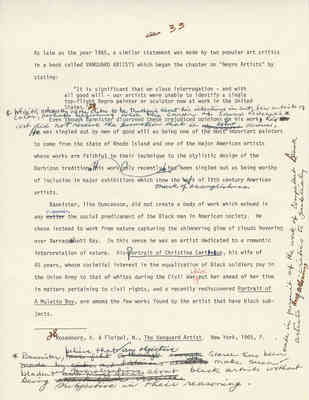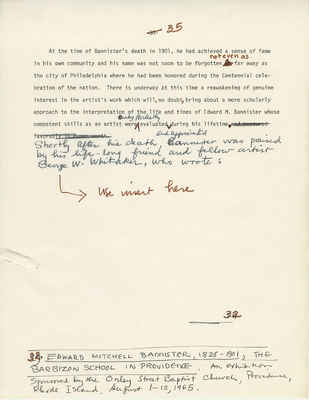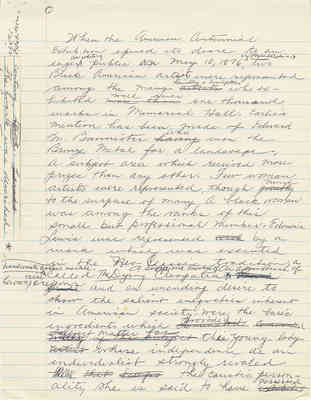Pages
MS01.01.03.B02.F10.036
[crossed out: 27] 32
given was that he was a [crossed out: Bl] black man and it was not a customary act to receive people of color at such functions. Thus began a conflict in the artist's life which seemed to have been an unfounded punishment for the superb talent he exhibited at the Centennial Exhibition. He has been singled out to win an award based on merit of [crossed out: the] his work which took into consideration the aesthetic value of his painting. Perhaps, the jury which singled Bannister out as a winner of the most coveted award in America at that time did not know that he was a [crossed out: B] black man.
Bannister, though fully aware of the risks taken of being an artist in a racist society, more specifically, one which was still wrestling with the lingering evils of slavery in which it had been engaged since its founding, had not expected to be treated in such an inhumane manner since his talent was what was supposedly being judged. [crossed out: But what is clear abouth this episode in American] [crossed out: This denial of Bannister's right as an artist] One is therfore tempted to work the questions; Did this episode in American cultrual history [crossed out: is that is] signal [crossed out: led] the approval of a segregationist attitude in American art among some professionals, when Black artists' works [crossed out: are] were at stake, which has lasted into our own times? Was "Black Art" in America actually born of the seeds of prejudice and racial segregation from the very beginning? William J. Simmons, writing a biographical sketch of the artist in MEN OF MARK, states that Bannister wanted to disprove a statement which was published in 1867 in the NEW YORK HERALD which noted "... that while the Negro may harbor an appreciation of art, he is unable to produce it". Obviously, this Herald writer had never seen the genius of Robert S. Duncanson's artistry which had won him fame in the major European capitals when the article was written.
However, one would assume that one-hundered years hence, such misconceptions and generalizations would no longer be written or would be limited to the unpopular rhetoric of a small band of uneducated champions of racist causes. Unfortunately, this not the case.
MS01.01.03.B02.F10.037
As late as the 1965, a similar statement was made by two popular art critics in a book called VANGUARD ARTISTS which began the chapter on "Negro Artists" by stating:
"It is significant that on close interrogation - and with all good will - our artists were unable to identify a single top-flight Negro painter or sculptor now at work in the United States."
While it is noteworthy of the critic to be truthful about his intentions in art, few artists of color, perhaps beginning with the career of Edward Mitchell. Even though Bannister disproved these predjudiced opinions in his work, and did not receive the promotion that it about desired. He was singled out by men of good will as being one of the most important painters to come from the state of Rhode Island and one of the major American artists whos works are faithful in their technique to the stylistic design of the Barbizon tradition. His work has been singled out as being worthy of inclusion in major exhibitions which show the mark of accomplishment of 19th century American artists.
Bannister, like Duncanson, did not create a body of work which echoed in any manner the social predicament of the Black man in American society. He chose instead to work from nature capturing the shimmering glow of clouds hovering over Narragasett Bay. In this sense he was an artist dedicated to a romantic interpretation of nature. His Portrait of Christiana Carteux, his wife of 45 years, whose societal interest in the equalization of Black soldiers pay in the Union Army to that of whites during the Civil War which put her ahead of her time in matters pertaining to civil rights, and a recently rediscovered Portrait of A Mulatto Boy, are among the few works found by the artist that have black subjects.
Rosenberg, H. & Fleigel, N., The Vanguard Artist. New York, 1965, P.
*Bannister, believe that an objective search has been made in pursuit of the work of competent [?]
MS01.01.03.B02.F10.038
Bannister was not very far removed in time from the days and chains of slavery when he proved to be one of the most important genre artists living in America. I have cited in his role in the founding of the Providence Art Club which was an unprecedented act for a man of color in America art circles at that time. His painting sold for handsome sums, some bringing as much as $1,500, and enviable amount for an artist's work who had not joined the parade of Americs who had studied abroad. His choice of subject matter was shaped by a conscientious approach to the use of a heavy impasto in the technic employed which almost always allows the viewer to identify his work even when there is no signature. In an article written in 1901 at the death of the artists, J.K. Otto spoke of the influence that the French painters in the Barbizon tradition exerted over those American artist who had studied abroad. Here, and sincere admiration by Bannister for those artists who brought back to America the Barbizon mood in painting. He has also been linked with those young painters who fell under the influence of William Morris Hunt during the 1860's.
Daniel Robbins described Bannister as an artist who exhibited a less sophisticated than personal approach to painting. He goes on to explain: "He represents the level of Providence painting at the moment when the community determined actively to engage itself in the promotion of art; and, as an American Negro, he represents one of the earliest artists to achieve recognition in a field where none had practiced before."
Otto, J.K., The Barbizon School in Providence, 1828-1901, Exhibition Sponsored by the Onley Street Baptist Church, August 1-5, 1965, p.3.
Birmingham, Peter, American Art in the Barbizon Mood, Smithsonian Institution, 1975, p. 126.
Robbins, Daniel, Edward Mitchell Bannister, 1828-1901 Providence Artist, Rhode Island School of Design for the Museum of African Art, Washington, D.C., March 23, April 3, 1966.
MS01.01.03.B02.F10.039
[crossed out: 30] 35 At the time of Bannister's death in 1901, he had achieved a sense of fame in his community and his name was not soon forgotten not even as [crossed out: as] far away as the city of Philadelphia where he had been honored during the Centennial celebration of the nation. There is underway at this time a reawakening of genuine interest in the artist's work which will, no doubt, bring a more scholarly approach to the interpretation of the life and times of Edward M. Bannister whose competent skills as an artist were only partially evaluated and appreciated during his lifetime. [crossed out: and measured favorably in human worth] Shortly after his death, Bannister was praised by his life-long friend and fellow artist George W. Whitaker, who wrote:
[footnote: use insert here]
32 [crossed out: 29]
32. EDWARD MITCHELL BANNISTER, 1828-1901, THE BARBIZON SCHOOL IN PROVIDENCE, An exhibition sponsored by the Onley Street Baptist Church, Providence, Rhode Island, August 1-15, 1965.
MS01.01.03.B02.F10.040
1 When the American Centennial Exhibition opened its doors to an eager [Superscript: ^awaiting ][superscrpt: public] this May 10, 1876, [superscript: in Philidelphia] two Black American artists were represented among the many painters + sculpters [struck out: artists] who exhibited well over [struck out: more than] one thousand works in Memorial Hall. Earlie's Mentioir has been made of Edward M. Bannister who. [struck out: having] [cuon?] the Bronze Metal for a landscape, a subject area which received more prizes than any others. Few woman artists were represented, Though much [struck out: greatly] to the surprise of many a black woman was among the ranks of this small but professional number. Echmonia Lewis was represented [struck out: with] by a work which was executed in the Neo-Classic Tradition, a called The Dying Cleopatra *^[struck out: illegible] [Side note: *sensitive knowledge of An architecture of handsome,^her own ^racial corked marble,] original and an unending desire to Show the salient inequalities inherent in American society- were the basic ingredients which Provided [struck out: clominated commanded] subject matter for this young lady [struck out: many of the subject] [struck out: artist] whose independence as an individualist strongly rivaled [Struck out: her that tempo] the caustic personality, she is said to have possessed [struck out: exhibited]
[In left margin]: *rive Exibition. Century, Africa. Larads The work was described*






